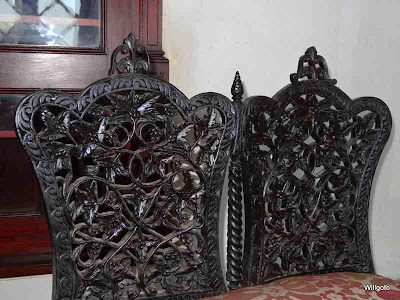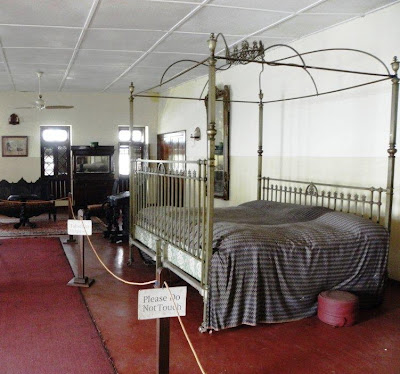 |
| Stonetown, Zanzibar, today. |
 |
| Zanzibar, circa the 1900s |
 |
| Etching of Stonetown in the 1800s |
One of the countries I wish were still a part of Oman, is Zanzibar. And the Congo. Wouldn't the Congo be better off if it were Omani?.
I have a love of Zanzibari culture, to the horror of my Omani inlaws, some of which have declared upon the tragedy of me not being an Omani woman yet married to a man of the family, that "alhamdulilah, at least you aren't Zanzibari!" lol. The first good Muslim I ever met was Zanzibari-Omani, so my experience of "Zanzibaris are so wild, and they mix and dance and are totally far from Omani culture" simply does not hold for me. I love how relaxed, okay, admittedly sometimes even so far as lazy, my Zanzibari friends are. It amuses me, how slow to finish anything but how quick to laugh they are, and help one. I love their food, I love the colours of their dresses, and I love their proverbs.
 |
| A rather embarssing gift from Queen Victoria... an English carriage for the Sultan (as the carriage was seen by the Omanis to be more fitting for women) |
Anyways, back to the point of this post... Since 1698 Zaznibar had been a part of the Sultanate of Oman (Muscat). The Arabs forced out the Portuguese who had been brutalizing the locals (as they had a tendancy to do back then). Though these particular locals were kind of a chanegable lot, being like, save us from the Persians Oman! Save us from the Portuguese! Then of course, being like, save us from the Omanis! to the British---who eventually grew tired of them, when they realized they had no care to end the slave trade either. Anyways...
 |
| Slave market in Zanzibar, 1887 |
 |
| An old Mosque |
 |
| Cloves harvest |
Trade in ivory and slaves became important, clove plantations were established by the Arabs on the Island, and Oman's East African Empire came to include more that just Zanzibar itself... also the Eastern coast and ports, and territories towards Central Africa. This territory was known as Zinj.
Sayyid Said ibn Sultan al-Busaid (yes, that's right, one of Sultan Qaboos' ancestors---pictured above) moved the capital of Oman from Muscat to Stonetown, Zanzibar, in 1840. That's right, the capital of Oman was Stonetown, not Muscat in those days. After he died, his sons, both vying for the Imamship/Sultanship and fighting with one another, caused the seperation of Oman into two territories, the East African (Zinj) and Muscat. Muscat, much poorer, always seemed jealous of the relative ease of life for those in Zanzibar.
Majid ibn Sayyid Said ibn Sultan al-Busaid became Imam/ruler of Zanzibar (pictured above). He established a palace called Mtoni whose ruins are pictured above, along with a portrait of the man. His palace life and children actually are some of the most colourful characters in Zanzibar's history (which include pirates, and Dr. Linvingstone). I enjoyed immeansely reading the following two books, both available on Amazon:
"Princes of Zinj" by Genesta Hamilton. A history told in bright narrative, the first page had me laughing, and the history was so gripping, and experience of Arab life and slavery and politics and war so honest and not even the least bit orientalist in mindset, that I couldn't put it down and finished it in an afternoon. Definately recommended if you want to know about the end of the slave trade in an easy read. And...
"Memoirs of an Arabian Princess from Zanzibar" by Emily Reute, aka, Majid's rebel princess daughter Salme, who aided in freeing her brother from imprisonment to later lead a coup, and ran away to marry a German merchant. I especially love her observations about life in palaces Bait Sahel, and Bait Ajeeb, and Arab women as opposed to Western women. A well recommended history, available in Arabic as well.
Princess Salme experienced life in the two palaces, Bait Sahel (Shore House) and Bait Ajaib (Hous eof Wonders), both of which are museums well worth a little visit if ever you happen to be in Zanzibar.
 |
| Sultan Barghash, photo courtesy of Mauli and Fox, London |
 |
| Sultan Barghash pictured center. |
One of the most popular exhibition's here is Princess Salme's apartments, where old photographs and many of her personal items are on display.
Also, the state rooms; very ornate carved furniture:
More than one period of Sultans' apartments:
It is often noted the the museum is in ill-repair, due to lack of funding, but I think that lends a certain charm.
Anyways, I know Zanzibar is a bit far to make it to OPNO's day-trippin'/weekend get-away things-to-do-and-see outside of Oman section, but since it was once the capital of Oman;) I think we can make an exception for this wonderful, relaxed country.
 |
| Election held after the Zanzibar revolution |






















































1 comment:
Thank you Your understanding of Omani history in Zanzibar is very clear and understandable. Very enjoyable.Well done. Hamoud from Oman.
Post a Comment